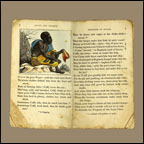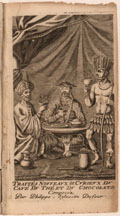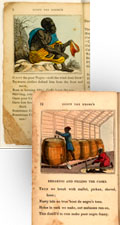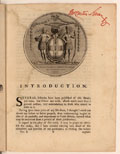| |
INTRODUCTION
Sugarcane and its products were imaged in many ways in the early modern period, but least often as the white crystals that we commonly associate with the sweetener. The cane itself was frequently depicted in a variety of contexts, didactic, symbolic, and aesthetic; it can be found on title pages of travel literature, in satiric prints and children’s books. Molasses and rum made their way into visual representation less frequently, although here we see how rum came to signify in both pro- and anti-slavery imagery.
|
|
| |
 |
|
|
Invisible Sweetener
"Traités nouveaux & curieux du café du thé et du chocolate," title page, engraving. In Philippe Sylvestre Dufour, Traitéz nouveaux & curieux du café, du thé et du chocolate. Lyon, 1685.
Sugar is an unseen but indispensible ingredient in this scene, as it was in so many images of polite conviviality in this period. This title page imagines the consumption of three increasingly popular beverages imported to Europe as a sociable meeting of a coffee-drinking Turk and a tea-drinking Chinese man. They sit and sip their drinks around a low table, while a Native American stands by (perhaps deemed too savage to share their table), bow in one hand and a large cup of chocolate in the other. While coffee, tea, and chocolate were routinely consumed at their points of origin without sugar, the soluble white crystals invisibly transformed these products into sweet consumables that appealed to European taste.
|
|
|
The Suriname Plantation as Garden of Eden
"Gestalte van een swarte slaaf en Slavinne," engraving. In J. D. Herlein, Beschryvinge van de volk-plantinge Zuriname. Leeuwarder, 1718.
This composition evokes Adam and Eve in the Garden, but this sweet paradise is produced by capital and hard physical labor. Sugarcane, growing thick and tall, forms the frame and the background for a scene that associates the labor of planting and harvesting with well-muscled black bodies, both male and female. The man appears directly connected to the cultivation of sugar; the woman is set slightly apart by the framing trees and is shown as exotic (note all the jewelry) and fecund—symbolized by the fruits that lie under her left hand.
|
|
|
The Evils of Rum and Freedom
A. Ducôtés, "Free labour, or, the sunny side of the wall," hand-colored lithograph. London, June 19, 1833.
Rum was a lucrative by-product of the sugar refining process. In the eighteenth and nineteenth centuries it was more likely to be pictured as a drink held by tipsy sailors in English caricatures than represented in allegories of colonial wealth or in diagrams detailing the stages of its West Indian production. In this pro-slavery satire, a flask of rum lays beside the dead or delirious figure of a former slave who can no longer labor and feed his starving family. This print promotes the argument repeatedly made by the West Indian interest that slaves were well-cared for by their benevolent masters, and were incapable of caring for themselves. |
|
|
Rum and Anti-slavery
“Cuffy.” hand-colored wood engraving. In Cuffy the Negro’s Doggrel Description of the Progress of Sugar. London, 1823.
"Breaking and Filling the Casks," hand-colored wood engraving. In Cuffy the Negro’s Doggrel Description of the Progress of Sugar. London, 1823.
Like the previous lithograph, these two woodcuts link the production of rum by slaves to the negative effects of rum on slaves. Rarely do texts or images represent the entire system of sugar commodification from the cane field to markets in Europe. Most descriptions stop at the water’s edge in the West Indies. An exception is this anti-slavery children’s book, which tracks in word and image the cultivation and processing of sugar in Barbados and its further refinement and sale in Britain. The crudeness of the wood engravings is matched by that of the doggerel set in the derogatory dialect of the comic “stage negro.” Together verse and image form a narrative that is racist and paternalistic as well as liberationist. These tensions are common in white anti-slavery discourse. |
|
| |
The entire book, Cuffy the Negro’s Doggrel Description of the Progress of Sugar. London, 1823, has been scanned. Read it here:

|
|
|
Sugar in the Background
Coat of arms of Jamaica, engraving. In Edward Long. The history of Jamaica. Or, General survey of the antient and modern state of that island, vol. 1. London 1774.
Sugar was the engine driving Jamaica, Britain’s most profitable colony in the eighteenth century, but it was not included on the colony’s original coat of arms (1661). However, sugarcane was added as a grassy flourish to this engraving of the seal, which appeared on the first page of the most authoritative eighteenth-century history of the island. The double spray of cane serves as a discreet background for the seal, which features a helmet (sign of British imperial power), tropical exotics (pineapple and a crocodile) and figures representing the native Arawak Indians, who mostly had been killed or driven out of Jamaica, and displaced by African slaves. |
|
|
Icing Slavery
Robert Cruikshank. "John Bull taking a clear view of the Negro slavery question." hand-colored etching, London, 1826.
This pro-West Indian satire is notable for its unusual and witty use of sugar in its white crystalline form. It appears as a snowy substance that covers the ground and ices the roof of “Canten Humbug and Co’s Free Sugar Warehouse.” John Bull’s telescopic view of the happy festive slaves on the shore of a West Indian island is obscured by the crude print of a slave being whipped, which a fanatical abolitionist waves before the lens. This pro-slavery print directly links the campaign to eliminate the duties on East Indian sugar with the campaign to abolish slavery in the West Indies. |
|
|
Sugar, Putti, and Heraldry
Bernard Picart, allegorical illustration on title page, engraving. In John Oldmixon, Het Britannische ryk in Amerika. Amsterdam, 1721.
A long stalk of cane, with its flowering top, lies in the foreground, while two putti carry bundled cane and another holds a skimmer used in the boiling house. Cones of refined sugar are strewn about the foreground and held by another putto. To the far right a lounging putto is sucking on a piece of cane. Putti were frequently used in the early modern period to represent industry and the arts. They do double duty here as stand-ins for black slaves and white consumers. The composition centers on and is framed by heraldic seals of corporate entities and the individuals to whom the book is dedicated (most were involved in the West Indian trade). This entire book is online on our collection at the Internet Archive. |
|
| |
Exhibition may be seen in Reading Room from SEPTEMBER 2013 through december 2013.
K. Dian Kriz (Professor Emerita of History of Art and Architecture, Brown University), guest curator, with assistance from Susan Danforth (Curator of Maps and Prints); Elena Daniele (JCB Stuart Fellow 2012-13), curatorial assistant. |
|









